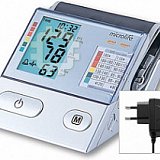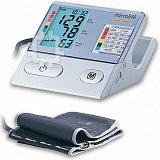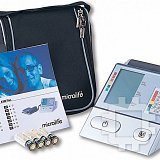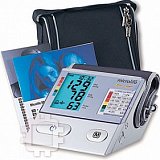Microlife BP A100 Plus: инструкция
Характеристики, спецификации
Инструкция к Тонометру Microlife BP A100 Plus

Europe / Middle-East / Africa
Microlife AG
Espenstrasse 139
9443 Widnau / Switzerland
Tel. +41 / 71 727 70 30
Fax +41 / 71 727 70 39
Email admin@microlife.ch
www.microlife.com
Asia
Microlife Corporation.
9F, 431, RuiGang Road, NeiHu
Taipei, 114, Taiwan, R.O.C.
Tel. 886 2 8797-1288
Fax.886 2 8797-1283
Email service@microlife.com.tw
www.microlife.com
North / Central / South America
Microlife USA, Inc.
Microlife BP A100 Plus
424 Skinner Blvd., Suite C
Dunedin, FL 34698 / USA
Tel. +1 727 451 0484
EN Ä 1
LV Ä 56
Fax +1 727 451 0492
FR Ä 8
LT Ä 64
Email msa@microlifeusa.com
www.microlife.com
NL Ä 16
EE Ä 72
SV Ä 24
RU Ä 80
FI Ä 32
DE Ä 88
DA Ä 40
IT Ä 96
NO Ä 48
IB BP A100 Plus V13-1 5010
IB BP A100 Plus V10 1010

Microlife BP A100 Plus
II
8
I
267 3
AK AL
AT18 9 5 4
BT
AQ
BM
AR
BK
AN
BL
AO
AS
APBN AM
Guarantee Card BP A100 Plus
Name of Purchaser / Nom de l'acheteur / Naam koper /
Inköparens
namn / Ostajan nimi / Forhandlers navn / Kjøpers navn / Pircēja
vārds / Pirkėjo pavardė / Ostja nimi / Ф.И.О. покупателя /
Name
des Käufers /
Nome del rivenditore
Serial Number / Numéro de série / Serienummer / Serienummer /
Sarjanumero / Serienummer / Serienummer / Sērijas numurs /
Serijos numeris / Seerianumber / Серийный номер / Serien-Nr. /
Numero di serie
Date of Purchase / Date d'achat / Datum van aankoop /
Inköpsdatum
/ Ostopäivämäärä / Købsdato / Kjøpsdato / Legādes datums /
Pardavimo data / Ostukuupäev / Дата покупки / Kaufdatum /
Data
III
IV
d’acquisto
Specialist Dealer / Revendeur / Specialist Dealer /
Återförsäljare /
Alan kauppias / Specialforhandler / Spesialist forhandler /
Speciālists - pārstāvis / Pardavusi įstaiga / Ametlik müügiesindaja /
Специализированный дилер / Fachhändler /
Categoria rivenditore

Microlife BP A100 Plus
EN
1
ON/OFF Button
Dear Customer,
2
Display
Your new Microlife blood pressure monitor is a reliable medical
3
Slot-in Card
instrument for taking measurements on the upper arm. It is simple
4
Cuff Socket
to use, accurate and comes highly recommended for blood pres-
5
Mains Adapter Socket
sure monitoring in your home. This instrument was developed in
6
collaboration with physicians and clinical tests proving its
Cuff Compartment
measurement accuracy to be very high.*
7
Battery Compartment
8
Please read through these instructions carefully so that you under-
Cuff
stand all functions and safety information. We want you to be
9
Cuff Connector
happy with your Microlife product. If you have any questions, prob-
AT
M-Button (Memory)
lems or want to order spare parts, please contact Microlife-
AK
MAM Switch
Customer Service. Your dealer or pharmacy will be able to give you
AL
Time Button
the address of the Microlife dealer in your country. Alternatively,
Display
visit the Internet at www.microlife.com where you will find a
wealth of invaluable information on our products.
AM
Heart Arrhythmia Indicator
AN
Pulse Rate
Stay healthy – Microlife AG!
AO
Battery Display
* This instrument uses the same measuring technology as the
AP
Stored Value
award winning «BP 3BTO-A» model tested according to the British
AQ
Systolic Value
Hypertension Society (BHS) protocol.
AR
Diastolic Value
AS
Pulse
BT
Date/Time
BK
MAM Mode
BL
MAM Interval Time
BM
Traffic Light Display
BN
Alarm Time
Type BF applied part
Read the instructions carefully before using this device.
1BP A100 Plus
EN

Table of Contents
1. Important Facts about Blood Pressure and Self-
1. Important Facts about Blood Pressure and Self-
Measurement
Measurement
• How do I evaluate my blood pressure?
•
Blood pressure is the pressure of the blood flowing in the
arteries generated by the pumping of the heart. Two values, the
2. Using the Instrument for the First Time
systolic (upper) value and the diastolic (lower) value, are
• Activating the fitted batteries
always measured.
• Setting the date and time
•
The instrument also indicates the pulse rate (the number of
• Selecting the correct cuff
times the heart beats in a minute).
• Selecting the measuring mode: standard or MAM mode
•
Permanently high blood pressure values can damage
• MAM Mode
your health and must be treated by your doctor!
3. Taking a Blood Pressure Measurement using this
•
Always discuss your values with your doctor and tell him/her if
Instrument
you have noticed anything unusual or feel unsure. Never rely
4. Appearance of the Heart Arrhythmia Indicator for early
on single blood pressure readings.
Detection
•
Enter your readings in the enclosed blood pressure diary. This
5. Traffic Light Indication in the Display
will give your doctor a quick overview.
6. Data Memory
•
There are many causes of excessively high blood pressure
• Viewing the stored values
values. Your doctor will explain them in more detail and offer
• Memory full
treatment where appropriate. Besides medication, relaxation
• Clearing all values
techniques, weight loss and exercise can also lower your blood
• How not to store a reading
pressure.
7. Replacing the Slot-in Card
•
Under no circumstances should you alter the dosages of
8. Setting the Alarm Function
any drugs prescribed by your doctor!
9. Battery Indicator and Battery change
•
Depending on physical exertion and condition, blood pressure is
• Low battery
subject to wide fluctuations as the day progresses. You should
• Flat battery – replacement
therefore take your measurements in the same quiet
conditions and when you feel relaxed! Take at least two
• Which batteries and which procedure?
measurements per day, one in the morning and one in the
• Using rechargeable batteries
evening.
10. Using a Mains Adapter
•
It is quite normal for two measurements taken in quick succes-
11. Error Messages
sion to produce significantly different results.
12. Safety, Care, Accuracy Test and Disposal
•
Deviations between measurements taken by your doctor or in
• Safety and protection
the pharmacy and those taken at home are quite normal, as
• Instrument care
these situations are completely different.
• Cleaning the cuff
•
Several measurements provide a much clearer picture than
• Accuracy test
just one single measurement.
• Disposal
•
Leave a small break of at least 15 seconds between two
13. Guarantee
measurements.
14. Technical Specifications
•
If you are pregnant, you should monitor your blood pressure
Guarantee Card
very closely as it can change drastically during this time!
i
2

•
If you suffer from an irregular heartbeat (arrhythmia, see
2. You can now set the month using the M-button. Press the time
«Section 4.»), measurements taken with this instrument should
button to confirm and then set the day.
only be evaluated after consultation with your doctor.
3. Please follow the instructions above to set the day, hour and
•
The pulse display is not suitable for checking the
minutes.
frequency of heart pacemakers!
4. Once you have set the minutes and pressed the time button, the
How do I evaluate my blood pressure?
date and time are set and the time is displayed.
Table for classifying blood pressure values in adults in accordance
5. If you want to change the date and time, press and hold the time
with the World Health Organisation (WHO) in 2003. Data in mmHg.
button down for approx. 3 seconds until the year number starts
to flash. Now you can enter the new values as described above.
Range Systolic Diastolic Recommendation
Selecting the correct cuff
blood pressure
z 100 z 60 Consult your doctor
Microlife offers 3 different cuff sizes: S, M and L. Select the cuff
too low
size to match the circumference of your upper arms (measured by
1. blood pressure
100 - 120 60 - 80 Self-check
close fitting in the centre of the upper arm). M is the correct size
optimum
for most people.
2. blood pressure
120 - 130 80 - 85 Self-check
Cuff size for circumference of upper arm
normal
S 17 - 22 cm (6.75 - 8.75 inches)
3. blood pressure
130 - 140 85 - 90 Consult your doctor
M 22 - 32 cm (8.75 - 12.5 inches)
slightly high
L 32 - 42 cm (12.5 - 16.5 inches)
4. blood pressure
140 - 160 90 - 100 Seek medical advice
too high
)
Only use Microlife cuffs.
5. blood pressure
160 - 180 100 - 110 Seek medical advice
X
Contact Microlife Service if the enclosed cuff 8 does not fit.
far too high
X
Connect the cuff to the instrument by inserting the cuff
6. blood pressure
180 y 110 y Urgently seek
connector 9 into the cuff socket 4 as far as it will go.
dangerously
medical advice!
Selecting the measuring mode: standard or MAM mode
high
This instrument enables you to select either standard (standard
The higher value is the one that determines the evaluation.
single measurement) or MAM mode (automatic triple measure-
Example: a readout value between 150/85 or 120/98 mmHg indi-
ment). To select standard mode, slide the MAM switch AK on the
cates «blood pressure too high».
side of the instrument downwards to position «1» and to select
The slot-in card 3 on the front of the instrument shows ranges
MAM mode, slide this switch upwards to position «3».
1-6 in the Table.
MAM Mode
•
In
MAM
mode, 3 measurements are automatically taken in
2. Using the Instrument for the First Time
succession and the result is then automatically analyzed and
Activating the fitted batteries
displayed. Because blood pressure constantly fluctuates, a result
Pull out the protective strip projecting from the battery compart-
determined in this way is more reliable than one produced by a
ment 7.
single measurement.
Setting the date and time
•
After pressing the ON/OFF button 1, the selected MAM mode
appears in the display as the MAM-symbol BK.
1. After the new batteries are fitted, the year number flashes in
the display. You can set the year by pressing the M-button AT.
•
The bottom right hand section of the display shows a 1, 2 or 3 to
To confirm and then set the month, press the time button AL.
indicate which of the 3 measurements is currently being taken.
3BP A100 Plus
EN

•
There is a break of 15 seconds between the measurements
10.
The result, comprising the systolic
AQ
and the diastolic
AR
blood
(15 seconds is adequate according to «Blood Pressure Moni-
pressure and the pulse
AS
is displayed and longer beep is heard.
toring, 2001, 6:145-147» for oscillometric instruments). A count
Note also the explanations on further displays in this booklet.
down indicates the remaining time and a beep will sound
11. When the measurement has finished, remove the cuff and
5 seconds before the 2nd and 3rd readings will begin.
pack it into the instrument as shown in Fig. II.
•
The individual results are not displayed. Your blood pressure
12. Enter the result in the enclosed blood pressure pass and
will only be displayed after all 3 measurements are taken.
switch off the instrument. (The monitor does switch off auto-
•
Do not remove the cuff between measurements.
matically after approx. 1 min.).
•
If one of the individual measurements was questionable, a
fourth one is automatically taken.
)
You can stop the measurement at any time by pressing the
ON/OFF button (e.g. if you feel uneasy or an unpleasant
3. Taking a Blood Pressure Measurement using this
pressure sensation).
Instrument
4. Appearance of the Heart Arrhythmia Indicator for
Checklist for taking a reliable measurement
early Detection
1. Avoid activity, eating or smoking immediately before the
The symbol
AM
indicates that pulse irregularities were detected
measurement.
during the measurement. Therefore, the result may deviate from your
2. Sit down for at least 5 minutes before the measurement and
normal blood pressure – repeat the measurement. In most cases, this
relax.
is no cause for concern. We advise you to tell your doctor if the symbol
3. Always measure on the same arm (normally left).
appears on a regular basis (e.g. several times a week with measure-
ments taken daily). Show your doctor the following explanation:
4. Remove close-fitting garments from the upper arm. To avoid
constriction, shirt sleeves should not be rolled up - they do
Information for the doctor on frequent appearance of the
not interfere with the cuff if they are laid flat.
Arrhythmia indicator
5. Always ensure that the cuff is positioned correctly, as shown
This instrument is an oscillometric blood pressure monitor that
in the pictures illustrated on the short instruction card.
also analyses pulse frequency during measurement. The instru-
• Fit the cuff closely, but not too tight.
ment is clinically tested.
• Make sure that the cuff is 2 cm (0.75 inch) above your
The arrhythmia symbol is displayed after the measurement, if pulse
elbow with the tube on the inside of your arm.
irregularities occur during measurement. If the symbol appears
• Support your arm so it is relaxed.
more frequently (e.g. several times per week on measurements
• Ensure that the cuff is at the same height as your heart.
performed daily) we recommend the patient to seek medical advice.
6. Press the ON/OFF button 1 to start the measurement.
The instrument does not replace a cardiac examination, but
7. The cuff will now pump up automatically. Relax, do not move
serves to detect pulse irregularities at an early stage.
and do not tense your arm muscles until the measurement
result is displayed. Breathe normally and do not talk.
5. Traffic Light Indication in the Display
8. When the correct pressure is reached, the pumping stops
The bars on the left-hand edge of the traffic light display BM show
and the pressure falls gradually. If the required pressure was
you the range within which the indicated blood pressure value lies.
not reached, the instrument will automatically pump some
Depending on the height of the bar, the readout value is either
more air into the cuff.
within the normal (green), borderline (yellow) or danger (red)
9.
During the measurement, the heart symbol
AN
flashes in the
range. The classification corresponds to the 6 ranges in the Table
display and a beep sounds every time a heartbeat is detected.
as defined by the WHO, as described in «Section 1.».
4

6. Data Memory
8. Setting the Alarm Function
At the end of a measurement, this instrument automatically stores
This instrument allows you to set 2 alarm times at which an alarm
each result, including date and time.
signal will then be triggered. This can be a useful aid, for instance
Viewing the stored values
as a reminder to take medication.
Press the M-button AT briefly, when the instrument is switched
1. To set an alarm time, press the time button AL (the instrument
off. The display first shows «M» AP and then a value, e.g. «M 17».
must have been switched off beforehand) and immediately
This means that there are 17 values in the memory. The instrument
afterwards the M-button AT and hold both down until the bell
then switches to the last stored result.
symbol BN appears in the bottom left of the display. Then
Pressing the M-button again displays the previous value. Pressing
release both buttons. The flashing «1» in the display indicates
the M-button repeatedly enables you to move from one stored
that the first alarm time can now be set.
value to another.
2. Press the time button to set the hours – the hour display flashes
Memory full
and pressing the M-button allows you to set the alarm hour. To
confirm, press the time button.
Pay attention that the maximum memory capacity of 200 is
not exceeded. When the memory is full, the old values
3. The minute display will now flash. The minutes can be set using
are automatically overwritten with new ones. Values
the M-button. To confirm, press the time button again.
should be evaluated by a doctor before the memory capacity
4. The bell symbol will now flash. Use the M-button to select
is reached – otherwise data will be lost.
whether the alarm time is to be active (bell) or inactive (crossed-
out bell). To confirm, press the time button.
Clearing all values
If you are sure that you want to permanently remove all stored
X
To set a second alarm time, proceed as above but if the «
1
» flashes,
values, hold down the M-button (the instrument must have been
press the M-button to select «
2
» and confirm with the time button.
switched off beforehand) until «CL» appears and then release the
X
An active alarm time is indicated by the bell symbol in the display.
button. To permanently clear the memory, press the M-button
X
The alarm will sound at the set time every day.
while «CL» is flashing. Individual values cannot be cleared.
X
To switch-off the alarm when it is sounding, press the ON/OFF
How not to store a reading
button 1.
Press the ON/OFF button 1 while the reading is being displayed.
X
To permanently switch off the alarm, proceed as above and
Keep the button pressed until «M» AP is flashing and then release
select the crossed-out bell symbol. This will then disappear
it. Confirm by pressing the M-button.
from the display.
X
The alarm times must be re-entered each time the batteries are
7. Replacing the Slot-in Card
replaced.
You can replace the slot-in card 3 by pulling it out to the side, as
9. Battery Indicator and Battery change
shown in Fig. IV and replacing the paper insert.
It may be helpful to have your doctor note down the medication
Low battery
dosage or an emergency telephone number on the card. Extra
When the batteries are approximately ¾ empty the battery symbol
cards are supplied with the instrument for this purpose.
AO will flash as soon as the instrument is switched on (partly filled
battery displayed). Although the instrument will continue to
measure reliably, you should obtain replacement batteries.
5BP A100 Plus
EN












